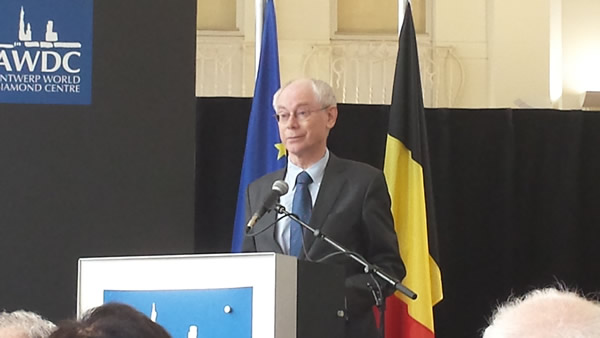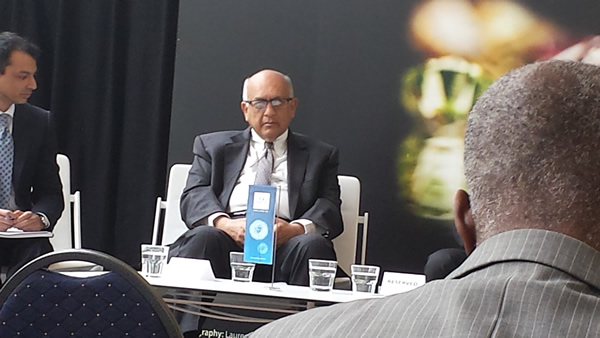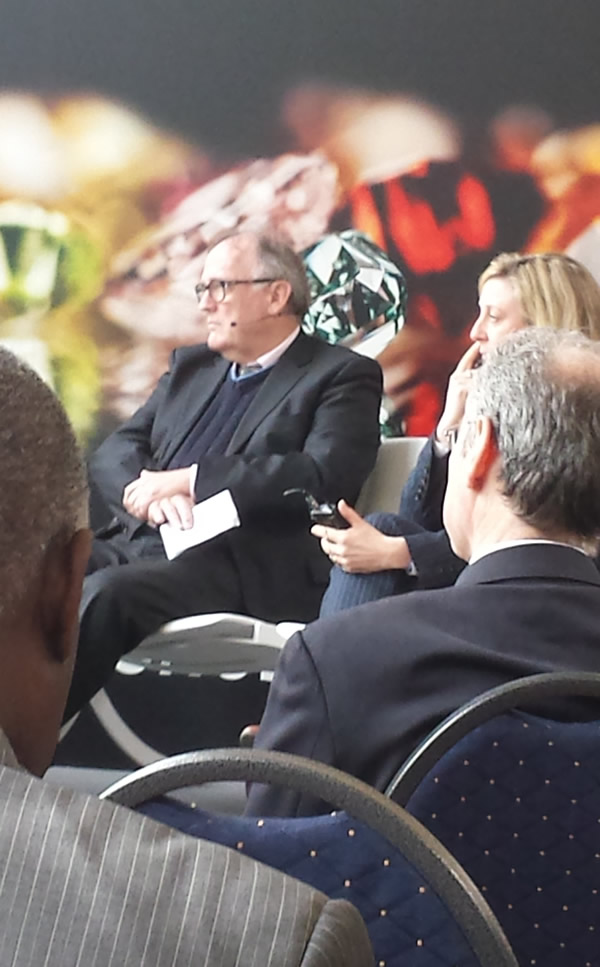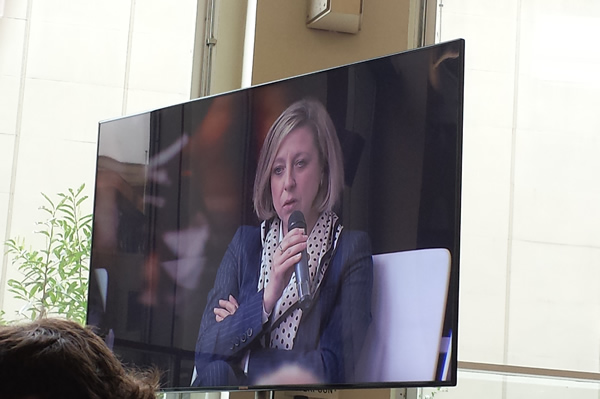Antwerp Diamond Centre – Friday 27 March 2015.
On March 27 of this year the AWDC, Antwerp World Diamond Centre, invited members of the diamond industry to reflect on the financial future of the sector. Although the speakers recognized the unique nature of the diamond industry, they defended an overriding principle: banks will support those who comply with the transparency and compliance rules fixed by them. This represents a considerable challenge…
Here are the actual key points straight from the seminar in Antwerp last Friday (03/27/15). Many representatives from the industry accepted the invitation from AWDC. It is true that liquidity problems and the dialog with banks have been key issues in recent months! The stated objective: to face up to many challenges, drive a dynamic change and build a context where the diamond industry can continue to move forward.
 The seminar began with a speech by Herman Van Rompuy, the guest of honor, in his capacity as former chairman of the European Council (2010-2014) and Prime Minister of Belgium. For him there is no doubt “that Antwerp needs Europe in order to remain competitive” and must make efforts, when faced with competition from other centers, to claim its place in the industry without fearing an opening of the market. He confirmed that “a shortage of liquidities is a major problem” and asked the diamond industry to “hold strong values“.
The seminar began with a speech by Herman Van Rompuy, the guest of honor, in his capacity as former chairman of the European Council (2010-2014) and Prime Minister of Belgium. For him there is no doubt “that Antwerp needs Europe in order to remain competitive” and must make efforts, when faced with competition from other centers, to claim its place in the industry without fearing an opening of the market. He confirmed that “a shortage of liquidities is a major problem” and asked the diamond industry to “hold strong values“.
Three representatives from the financial sector were on the podium for the debate:
 ● Kishore Lall, Managing Director and Global Head of Diamonds & Jewelry at Standard Chartered Bank, London.
● Kishore Lall, Managing Director and Global Head of Diamonds & Jewelry at Standard Chartered Bank, London.
● Des Kilalea Capital Markets Equity Research Analyst at RBC Capital Markets and a longtime diamond industry analyst.
● Sabine Smets Head Belgium – Diamond & Jewellery Clients at ABN AMRO, principal financier of the diamond industry.
Why is the diamond industry so unappealing to banks?
[two_third]The three panelists admit that diamond industry is certainly “unusual” compared with other industries. But global financial challenges are currently too large for it not to adapt, or to risk finding itself in a critical situation. For Khishore Lall, the persistent rumors that the diamond industry is “classed as high risk” have been prejudicial. If it wishes to maintain—or create—a dialog with the banks, the industry must accept greater transparency. As for Antwerp, although its geographical position may be central, as a market place it cannot rival London.[/two_third][one_third_last]
“The industry has to work on four key points : transparency, bankability, profitability and sustainability.”
[/one_third_last]
For her part, Sabine Smets asks the industry—beginning with mining companies—to look to the future by working on four key points:
● Transparency
● Bankability
● Profitability
● Sustainability
In her view, the Indian system where “risks are limited and sufficient financing is available can serve as an example” to understand how to encourage banks “to put more money on the table“.
 Because there is no shortage of financing possibilities! For Des Kilalea, the diamond industry which, on a global scale, does not represent such a big market share as other industries, must understand how to be “more efficient“. “There are certainly some good opportunities in the diamond industry” [for banks], “but this is hard to see for the outside world,” he explained. Tools therefore need to be created to make this sector more intelligible and easier to understand.
Because there is no shortage of financing possibilities! For Des Kilalea, the diamond industry which, on a global scale, does not represent such a big market share as other industries, must understand how to be “more efficient“. “There are certainly some good opportunities in the diamond industry” [for banks], “but this is hard to see for the outside world,” he explained. Tools therefore need to be created to make this sector more intelligible and easier to understand.
Spread the risks
Some major banks, in Dubai for instance, are showing increasing interest in the diamond industry. But Kishore Lall considered that “the oxygen should not just come from foreign banks. It must also come from local banks.” Sabine Smets supported this notion: “The interest must not come just from the few existing banks” who currently finance the diamond industry. Other banks must feel comfortable with the idea of investing in the sector. She therefore encourages “risk sharing amongst the banks. Which would equate to sharing risks amongst their customers. Solutions must be found for this industry and for Antwerp in particular.”
Supply that meets demand
The prices of rough and polished, another essential point raised during the debate must “be restricted” according to Des Kilalea, especially considering the lack of liquidities and the tightening of margins. In any other industry, market price is determined by demand, “supply must adapt to demand” in the diamond industry as well.
Long-term profitability
The ultimate challenge is to move the diamond industry into a dynamic of long-term profitability.
By what means? Could it be possible to seek ways to reduce costs “in-house” or should we encourage a drop in rough prices? Kishore Lall defends the idea that profitability will come from a group dynamic and a good understanding between all the players in the sector: miners, manufacturers, retailers, diamond centers, etc. To defend everybody interests we have to bring an end to discussions and in fighting. Des Kilalea explains that the difference between the point of view of the miners and the rest of the industry can also be explained by the definition of the mining activity in general: “When a mine is finally opened, taking into account the risk capital invested, many people expect an immediate return on their investment.”
Transparency? A competitive advantage
 “Even if this industry is different from others, this is no reason not to comply with the financial laws that others comply with!” Kishore Lall answered to a lively reaction from the audience. Des Kilalea further added that the mining companies must provide a “clean” product which will make “everybody in this room happy“. Sabine Smets, representing ABN AMRO, directly answered some of the real concerns of people in the room: “We have received over a hundred requests to open accounts. I have asked my team to pick up the phone and call every demander, to take the time to listen to their story and to be attentive. We will consider every request but we are not going to open accounts for just anybody. Yes, transparency is becoming a competitive advantage.”
“Even if this industry is different from others, this is no reason not to comply with the financial laws that others comply with!” Kishore Lall answered to a lively reaction from the audience. Des Kilalea further added that the mining companies must provide a “clean” product which will make “everybody in this room happy“. Sabine Smets, representing ABN AMRO, directly answered some of the real concerns of people in the room: “We have received over a hundred requests to open accounts. I have asked my team to pick up the phone and call every demander, to take the time to listen to their story and to be attentive. We will consider every request but we are not going to open accounts for just anybody. Yes, transparency is becoming a competitive advantage.”
In conclusion, greater transparency remains the key to ensuring a win-win relationship between banks, the industry and Diamond consumers.
Lively reactions from the participants
With a poor image in the media in general, indignation regarding the attitude of the banks and the banks refusal to open a dialog, the public at the seminar was highly sensitive. It is striking how powerless and alone the representatives of the small and medium enterprises in Antwerp feel as part of a diamond industry that is going through major changes, which run contrary to everything they have known until now. The division between two worlds and the difficulty of adapting to the criteria set by banks and the transparency rules are palpable. Opening a bank account, taxation and finance are three problems that must be discussed with the powers that be…
